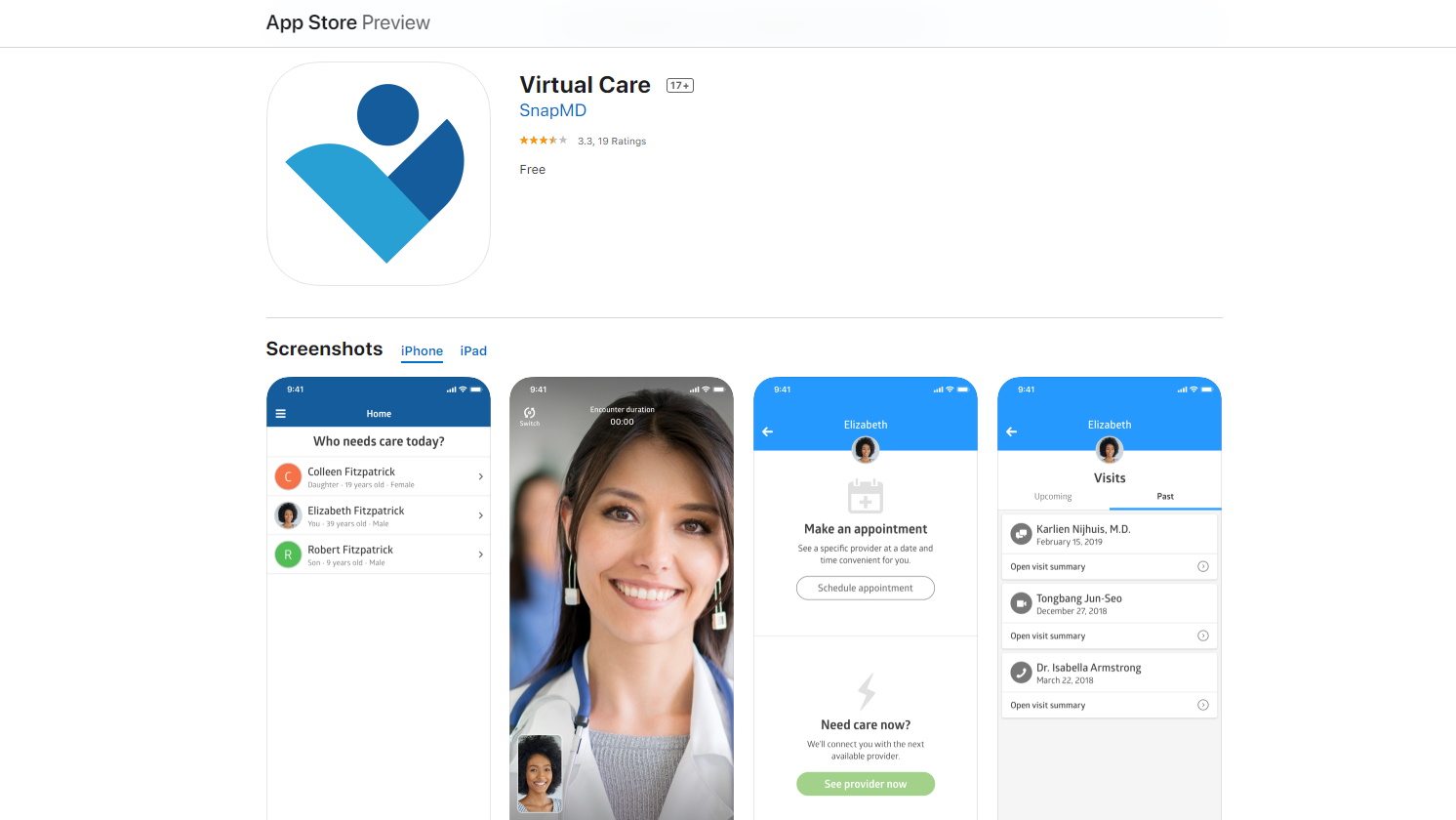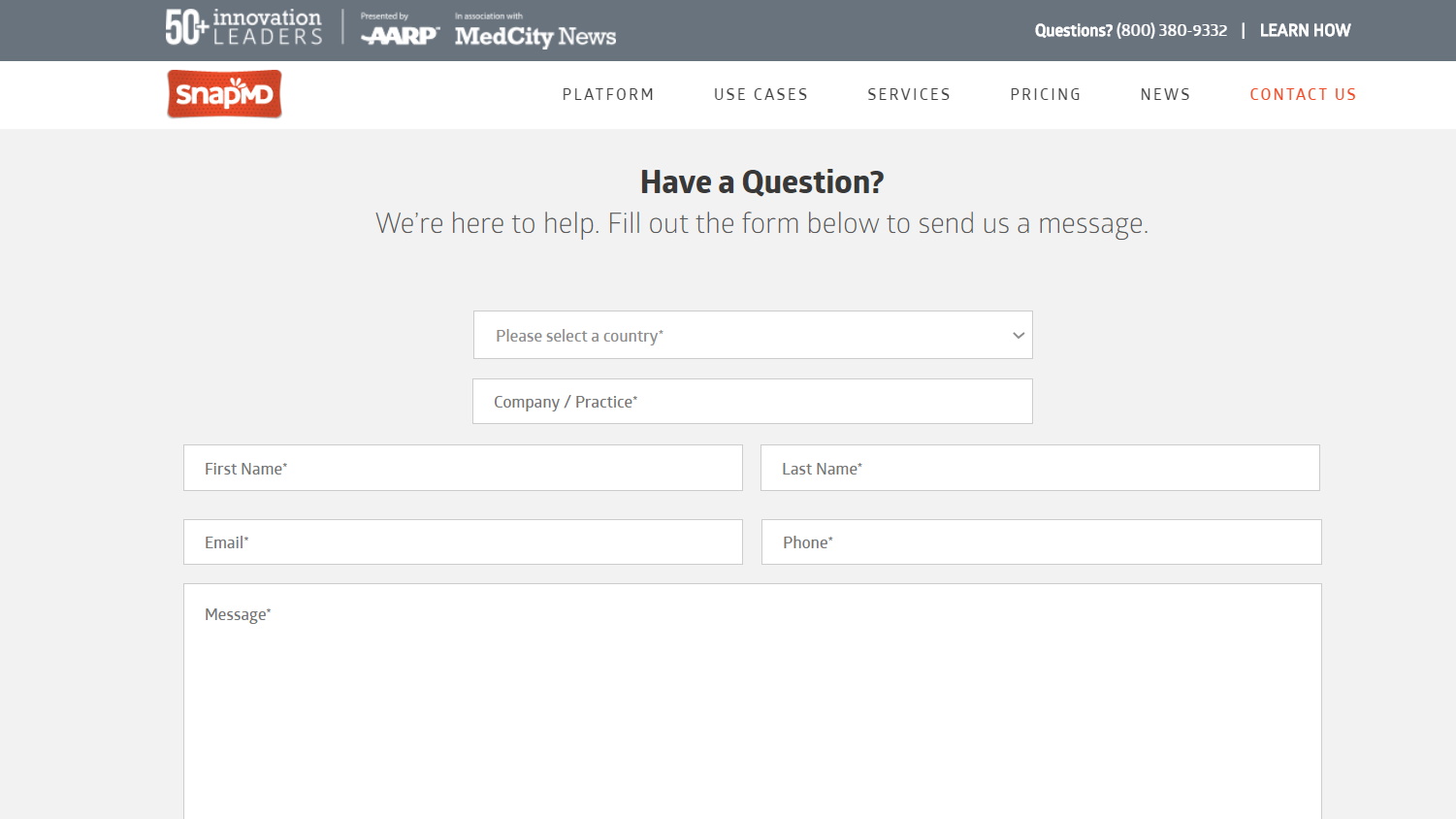SnapMD
SnapMD was founded in 2013, and offers its enterprise-level Virtual Care Management (VCM) platform for telehealth. This platform is HIPAA compliant, and cloud based. This company is based in Glendale, California, and is utilized by such notable health providers including the Infectious Disease Society of America (IDSA), the University of Mississippi Medical Center, and Fresenius Medical Care, a provider of almost 4,000 dialysis centers.
Features
SnapMD offers their Virtual Care Management product, designed to offer an encrypted, HIPAA compliant connection. Through this platform, consultations can be conducted via video, audio or even text message communication. A choice of devices can be used, which increases flexibility, and can range from laptops, smartphones and tablets so patients can connect to their providers from wherever they are.
According to SnapMD, providers that use this app can generate up to 35% additional revenue, along with increasing patient satisfaction. While the telehealth approach that SnapMD embraces is not ideal for every patient care scenario, there are still plenty of use case scenarios that it can be applied to, and lately this is being pushed even further with the COVID pandemic.
An excellent use case scenario for SnapMD’s telehealth is specialty consultations to the Emergency Department. While larger academic medical centers have the luxury of having developed services that have enough staffing for 24/7 coverage, more rural facilities, with smaller departments struggle to cover all the specialties, especially on the off hours and weekends. Stroke coverage can be especially challenging as it is critically important that the care is always available, and timely.
SnapMD is a turnkey solution that can facilitate coverage for some challenging specialties, and the list for its Specialty Consultations includes Stroke, Cardiac Episodes and Psychological Evaluations. Rather than facing the challenge of hiring an entire department for Emergency Department coverage, remote specialists, in the fields of neurology, cardiology and psychiatry, can conduct remote assessments, and render opinions in real time to ensure the patient receives ideal care, and without any delay.
Remote telehealth visits can also be applied to other scenarios as well, such as discharge planning. Preventable readmissions are a challenge that all facilities face, and there is significant financial incentive to make sure patients have access to resources after they are discharged and once they are home. SnapMD offers a remote telehealth service that targets the preventable readmission population. It starts with medication compliance, which is a frequent cause for the readmission. However, it goes way beyond that with HD video, allowing for collaboration between multiple team members, and sensors to allow for remote monitoring. Additional family members can even be looped into the conversation, to further increase compliance.

Drawbacks
SnapMD offers smartphone apps for both the iOS and Android platforms. They can also be used for the respective tablet platforms. Unfortunately, there are some issues with both apps.
On the Android side, overall the SnapMD app gets a lukewarm 3.5 out of 5 stars. More than one user complains of difficulties getting past the initial sign on. The problem focuses on entering the email address, which the system does not recognize. Also, others complain that they cannot enter their medical center when they sign up.
Things are hardly different on the iOS version of the app, with an even lower average rating than the Android app of 3.3 out of 5 stars. Again, users complain about the difficulties they have in entering their email address to configure the account initially. Another notes the difficulty that they had in finding out a cost in advance of their appointment, and were dismayed as they signed up for a mental health appointment that they expected to be more affordable, but then turned out to be a lofty $250 (£202).

Support
The support options on the website for SnapMD are somewhat limiting. A phone number is listed (long distance, not toll free), although it is unclear if this is for sales or support (or both). There is an address listed for ‘Snail mail’ although we doubt too many users would use this method to resolve an issue. There is an email listed for sales, and another for “General / Press / Investors,” which again leaves out support.
Rather, as seen in the screenshot above, there is an online portal that is clearly SnapMD’s preferred method for providing support. The user provides their email address and phone number, but it cannot be designated if the user has a preferred method of contact.
There are no hours of operation listed for support. Neither are there other options such as chat, or other supporting materials, such as eBooks, online seminars, or on demand video training.
Pricing
SnapMD has an entire web page that details the pricing information, with phrases that include “Flexible pricing plans,” “Lowering care costs,” and “A variety of business and pricing models,” that all sound quite promising and seriously enticing. A major shortcoming is nowhere is the actual cost of the service, as it is frustratingly opaque. It does state that it is a SaaS, with a subscription model that has integrated cloud backup built into it.
In addition, an internet search failed to turn up any more specific pricing info, to either an enterprise, or for the consumer side of things.
Final verdict
SnapMD offers an impressive array of services to target key challenges in healthcare, such as Specialty Consultations in the Emergency Department, and remote homecare to prevent readmissions. The limitations range from the opaque pricing, the lower rating on the apps, and the lack of support options. Overall, SnapMD offers a powerful solution in the competitive market of telehealth.
- We've also highlighted the best telemedicine software
0 comments:
Post a Comment